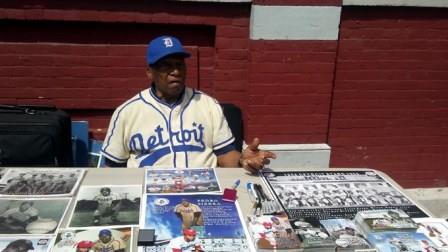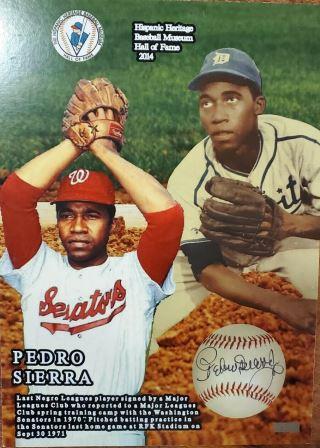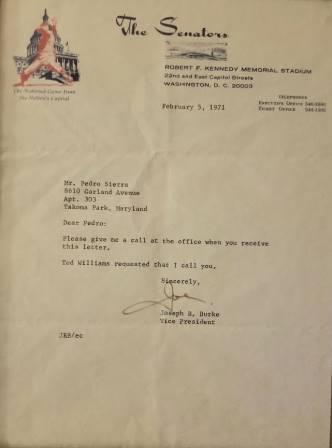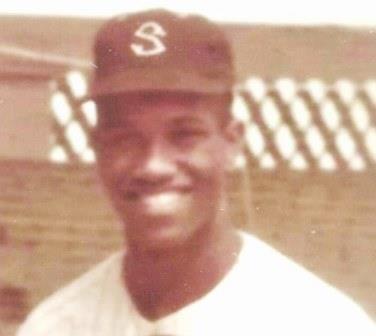Pedro Sierra, born in Havana, Cuba, July 26, 1938, is one of a few ex-Negro Leaguers still living. He pitched for the 1954 Indianapolis Clowns—managed by Oscar Charleston—and the 1955-58 Detroit Stars, whose skipper was Ed Steele. So, how did someone from the Lawton neighborhood of Havana, Cuba, end up pitching in the Negro Leagues; serving his “new” country in the military; playing minor-league, Canadian, and Mexican (summer) League baseball; pitching batting practice for Ted Williams’s 1970-71 Washington Senators; and, hooking up with George Henderson as an extra, in the film Major League II? The author conversed (by phone) with Sierra, Thursday, March 26, 2020, and accessed some past in-depth interviews, including Reynaldo Cruz’s March 23, 2018 piece, at
Sierra’s father (Pedro “Perico” Sierra) was a welterweight boxer in his youth. The barrio (Lawton) where the Sierra family grew up was home to Isidro Fabré, a pitcher for the Cuban Stars, All Cubans, Cuban Stars, and New York Cubans between 1918 and 1939. Fabré pitched for Almendares in the Cuban Winter League, and faced the 1920 New York Giants—reinforced by Babe Ruth—in a special 1920 off-season series. (Fabré was 2-1 on the mound, with one SHO; he hit for a .273 AVG against those Giants.) Vicente Amor, a minor-league pitcher, who won three games for Almendares in the first [1949] Caribbean Series, lived in that barrio. Rafael Almeida, the Cuban player, who along with Armando Marsans made his debut with the Cincinnati Reds on July 4, 1911, lived roughly a block away from the Sierra’s home. Sierra told Reynaldo Cruz that “at least once every two Sundays Marsans would go polish his shoes at the shoe polish seat of my dad (who opened his business every Sunday) and in very charismatic fashion, with his Panama hat, a cane in one hand and a cigar in the other, he would go down Calle Porvenir greeting every person tapping his hat…to polish his shoes and talk baseball with my dad.” Marsans would tell the elder Sierra (Perico) that “the morenitos (black players) should get to play in the big leagues.”

A scout named Máximo Sánchez made the arrangements for Sierra to join the 1954 Indianapolis Crowns, the same club which featured an 18-year old Henry Aaron, two years earlier, in 1952. Sierra recalled that manager Oscar Charleston, in his final year in baseball, before his passing would speak some Spanish to him when visiting the mound. “A el no le gusta curvas (he doesn’t like curve balls),” stated Charleston to Sierra. (Charleston was the CF with the 1923-24 Santa Clara Leopards in Cuba, a dream OF, with Pablo Mesa (LF) and Alejandro Oms in RF; Santa Clara finished 36-11, .766, 11.5 games ahead of Havana. Their pitchers included José de la Caridad Méndez plus imports including Bill Holland, Rube Currie, and Dave Brown.) Coincidentally, Charleston was an umpire in the 1946-47 Puerto Rico Winter League, per Jorge Colón Delgado. He was a native of Indianapolis who passed away on October 5, 1954, more than two decades before his 1976 induction in Cooperstown. Bill James considered Charleston to be the second-best CF ever, with only Willie Mays ranked ahead of him.
The Detroit Stars played home games at Briggs Stadium, but did a fair amount of road trips, including a double-header at Yankee Stadium. Ed Steele, the manager, was a 1948 teammate of Willie Mays with the Birmingham Black Barons, and a roommate of Lorenzo “Piper” Davis. Steele’s nickname was “Stainless Steele” since Birmingham, Alabama, was the “Steel City of the South.” His playing career included the U.S. minors, Canada (1953-54), and some games as Sierra’s Detroit teammate. The Detroit Stars were also called the Detroit Clowns in 1958, when Steele was player-manager. Their 1956 club finished 52-16, .765, in winning the Negro American League title. Steele managed the East squad, which included pitcher Pedro Sierra, in the 1955-58 East-West All-Star contests. The East won twice—11-5 in 1956 and 6-5 in 1958; losing 2-0 in 1955 and 8-5 in 1957.
Cuban Winter League Batting Practice Pitcher and U.S. Minor Leagues
Sierra returned to Cuba post-Negro League seasons, and pitched batting practice for three teams, including Havana Reds, aka Lions (1956-57); 1957–58 Cienfuegos Elephants; and 1958–59 Marianao Tigers. “Papa Joe” Cambria signed Sierra, upon a suggestion from Orestes “Minnie” Miñoso, whom Sierra knew from pitching batting practice in the Cuban Winter League. (Sierra first met Miñoso when he came to Lawton to meet a [Sierra’s] friend’s relative.) Sierra was anxious to play organized baseball. One day, Miñoso approached Sierra, and told him to see Joe Cambria, at his office, in the Pan American Building in La Rampa, Vedado. Finally (May 1959), Sierra was signed to a contract with the Sanford Greyhounds, Florida State League. “I was extremely lucky because the American Embassy did not want to issue a visa since the baseball seasons had already started,” said Sierra. “I guess they called Cambria’s office to confirm and the next day I was on my way to Florida…” But Sierra was released after pitching two games.

He had a relative in Washington, D.C., to stay with for a few weeks. Sierra lived for a time near Griffith Stadium, home of the Washington Senators. Fortunately, the 1959 Chicago White Sox were coming to town, and Sierra re-connected with Miñoso of the White Sox, and with two Senators pitchers from Cuba: Camilo Pascual and Pedro Ramos. “When Minnie saw me, he asked me what had happened; I was not playing. I explained what had happened and then he, Pascual and Ramos said that they were going to talk to the Senators and ask to give me a try-out. The following day I went to the Stadium, threw in the bullpen under the watchful eyes of Sherry Robertson, the Farm director, and Joe Haynes, the Senators vice-president. That same day I was resigned and told to report to the Lynchburg Senators of the Appalachian League… I could not be more thankful to Camilo, Pedro and Minnie.”
Sierra was signed by the Senators to a minor-league contract, and pitched for the 1959 Lynchburg Senators, Appalachian League. He told the author that Boog Powell, 1959 Bluefield Orioles, was a good prospect, and they later talked about that season at a function in Baltimore. Uncle Sam intervened, and Sierra was inducted for service in the U.S. Army. He served Stateside, and pitched well (16-5 W-L, 1.75 ERA) for his 1961 Fort Hood, Texas team.
The Minnesota Twins signed Sierra to a 1962 minor-league contract, and he spent the next five seasons in their system, at 1962 Erie, New York-Penn League; 1963 Bismarck-Mandan; 1964 Wisconsin Rapids; and 1965-66 Thomasville (North Carolina) Hi-Toms. With Bismarck, he established a friendship with LHP Rudy May, a teammate. He recalled Denny McLain pitched for 1963 Duluth-Superior. In 1964, he faced Dave May, a Baltimore Orioles prospect with Fox Cities. Sierra’s best season (1965), 6-4, 1.75 ERA, came as a reliever in the Western Carolina League for Thomasville. Bobby Bonds, Lexington Giants, was the “toughest hitter he faced that summer.” Al Oliver and Bob Robertson of Gastonia were two Pittsburgh Pirates prospects who were fine hitters, per Sierra. Sparky Anderson (Rock Hill) and Max Lanier (Gastonia) were two interesting characters who managed in the 1965 Western Carolina League. When Sierra returned to Thomasville in 1966, he faced Gil Torres, the league’s batting champion, with Spartanburg; and was impressed by a 19-year old pitching phenom with the Greenville (South Carolina) Mets named Nolan Ryan, who led that league in wins (17) and strikeouts (272).
Canada, Ted Williams, Back to U.S. Minors, and Mexico
Sierra knew that he was not going to pitch in the majors for the Twins, winners of the 1965 AL pennant with three key contributors from Cuba—AL MVP Zoilo Versalles at shortstop; Tony Oliva, winner of his second straight batting title, in RF; and, RHP Camilo Pascual. While Sierra was proud of his fellow Cubans, his time in the Twins organization ended in 1966. Jorge Taylor, a brother of Cuban Tony Taylor—IF with the Philadelphia Phillies—suggested that Sierra play for Coaticook Canadians, in Quebec’s Provincial League, 1967. Sierra was an All-Star, 11-3 with a 1.75 ERA, and happy with his surroundings-teammates, including Jorge Taylor, Mario Miranda, Jorge Brache, and catcher Pedro Lay, all from Cuba. Sierra joined the 1968 and 1969 Sherbrooke Alouettes. He was 11-7, 3.43 ERA in 1968, followed by a 14-win season and 3.26 ERA in 1969.

The Washington Senators signed Sierra to a 1970 minor-league contract, after he impressed Ted Williams in a late 1969 season tryout, after returning to the D.C. area from Canada. Sierra threw a 90 MPH fastball and a 12-to-6 overhand curve ball. Zoilo Versalles and Paul Casanova, respected veterans with Washington, put in a good word for Sierra. Ted Williams personally told Sierra he would During the 1970 and 1971 season, Sierra mostly pitched minor-league games for the Pittsfield Senators, as well as batting practice for the Washington Senators. This included the final Senators home game, September 30, 1971, versus the New York Yankees. Bobby Murcer, Roy White, and Rusty Torres homered for the Yankees, but a Frank Howard home run gave Washington a 7-5 lead after eight innings. Ted Williams brought in LHP Joe Grzenda for the ninth. He retired Felipe Alou and Bobby Murcer on grounders, but fans stormed the field when Horace Clarke stepped in. The game was forfeited to the Yankees. https://miscbaseball.wordpress.com/2010/10/06/the-forfeited-last-game-of-the-washington-senators-in-1971/
Sierra remembered September 30, 1971, as a sad, rainy day, in D.C. He continued his pitching career with the 1972 Puebla Pericos, in Mexico. He recalled pitching a no-hitter against Union Laguna, managed by Miguel Sotelo, when Sotelo pinch-hit for him. “Pedro Ramos, our pitching coach, got real made at Sotelo,” said Sierra. “Pedro eventually became the manager at the end of the season…fans didn’t really like him that much.” Sierra fondly recalled that Minnie Miñoso was player-manager for Union Laguna. José Calero from Puerto Rico was a friend; so was Héctor Espino, that league’s home run leader, with Tampico. “I was (later) traded to Tampico and told Héctor I “was so happy not to have to pitch to him.” Some of the toughest hitters for Sierra, in addition to Espino, were Rico Carty and Vic Davalillo, Cafeteros de Cordoba; Ricardo Joseph, Mexico City Red Devils; and Miñoso, Union Laguna. Aurelio López and Panchón Herrera were two of other friends from Mexico. Héctor Valle, Reynosa, was one of the top catchers. Sierra’s minor-league statistics can be found here.
The Cubans befriended by Sierra in his long minor-league career, included: 1959 Lynchburg Senators: IF Mariano “Oriente” Ramos, OF Luis Rangel, OF Carmelo “Mickey” Mesa, (called Mickey because he resembled Mickey Mantle); 1962 Erie Sailors: IF David Sánchez, OF Alberto Álvarez, OF Alberto Montalvo, and OF Ramón Buduen; 1963-66, during the Twins Minor Leagues spring training camps: IF Rigoberto “Kike” Mendoza, IF Néstor Velázquez, IF Hernán Valdés Vila, catcher Enrique Izquierdo, pitcher Héctor Maestri, IF José Valdivielso, OF Hilario “Sandy” Valdespino, Orlando “Pito” Martínez, and OF Tony Oliva; in 1970, at the Major League Baseball spring training camp with Washington Senators: IF Zoilo Versalles and catcher Paulino “Paul” Casanova.
A few of Sierra’s Stateside friends from the minors included Toby Harrah (IF), Bill Madlock (3B)—future 4x NL batting champ—and Pat Kelly (OF), who later played in the majors for Baltimore. Some of the best prospects he pitched against in the early 1970s were Jim Rice, Ben Oglivie, Cecil Cooper, and Carlton Fisk with Pawtucket (Red Sox); Mike Schmidt, Greg Luzinski, and Bob Boone with the Reading Phillies; and Richard Zisk, a top Pittsburgh prospect.
From 1973-to-1975, Sierra pitched for four teams in Mexico (1973); two clubs in Mexico (1974); one team in Mexico (1975); and, two teams in the Dominican Republic (1975). In 1973, he pitched a combined 128 innings in 32 games with Puebla, Tampico Alijadores, Mexico City Red Devils, and Chihuaha Dorados. He was 12-1 with a 4.57 ERA, per his baseball card mailed to the author. Top pitchers in the 1973 Class AAA Mexican League were Ed Bauta, a 23-game winner with Poza Rica Petroleros, and Silvio Quezada, 22-2, for Tampico. Sierra was 12-10 for Chihuaha and the Veracruz Aguila in 1974, as a starter, in 27 games and 174 innings. He fanned 63 and walked 57, with a 3.64 ERA. Juan “Terín” Pizarro led that 16-team league with a 1.57 ERA, with the Cordoba Cafeteros. Pizarro also pitched for the 1974 Chicago Cubs and 1974-75 Santurce Crabbers. “Many players from Puerto Rico end their careers in Mexico,” stated Pizarro. “That’s a fact of life.” Sierra, however, pitched one game for the 1975 Aguascalientes Rieleros before ending his playing career in the 1975 Cibao [Summer] League of the Dominican Republic. He was 2-3, 3.95 ERA, for San Francisco de Macoris in five starts and 36 innings; then, 8-4, 3.03 ERA with Puerto Plata in 18 starts and 125 innings. His pitching career ended at age 37.
Overall, Sierra had a 135-97 W-L record, including 36-13 in Canada, 38-24 in Mexico, 10-7 in the Dominican Republic, and 51-53 in the U.S. minor leagues. He was the last player from the Negro Leagues signed to a contract by an MLB team, when the 1970 Washington Senators brought him to spring training. He pitched batting practice for the Senators, including prior to their final game in Washington, D.C., on September 30, 1971.
Final Thoughts
Sierra’s post-baseball career included helping at-risk youth in Montgomery County, Maryland, near Washington, D.C. Sierra joined Essex Community College (now CCBC Essex) as assistant baseball coach for three years, 1993-to-1996, under George Henderson. While there, he got a bit part in the movie «Major League II» as third-base coach for the Chicago White Sox. Henderson was the Cleveland Indians third base coach in this film, released on March 30, 1994. https://www.baltimoresun.com/sports/bs-sp-negro-leagues-sierra-20170210-story.html
In 1997, the author met Johnny Welaj, in the press box at The Ballpark in Arlington (Texas), thanks to Luis Rodríguez Mayoral, Public Relations official, Texas Rangers. Welaj played for the 1939 Washington Senators when Lou Gehrig made his famous “Luckiest Man Speech” at Yankee Stadium, July 4, 1939, and was the 1971 Washington Senators Public Relations officer, when they forfeited their September 30, 1971 final home game, preceded by Pedro Sierra’s pitching batting practice. In 2002, Sierra coached the Atlantic League’s Road Warriors. In 2004, manager Bill Madlock hired him as a coach with the Newark Bears. Sierra also coached in the 2006-07 Can Am League.
Sierra followed Satchel Paige’s philosophical approach of “The home plate is 50% the batter side, 50% the pitchers side: DO NOT COME INTO MY SIDE.” Sierra, per published interviews, “never aimed at a hitter’s head; my brushback was always aimed from the shoulders down. And I had a pretty good live fastball which I think topped 90 MPH.” Several of his toughest outs in the Negro Leagues, were Otha Bailey, a catcher with the Birmingham Black Barons; and, George Altman, 1B-OF with the Kansas City Monarchs, who also starred for the 1959-60 Cienfuegos Elephants in Cuba, league and February 1960 Caribbean Series Champions.
With special thanks and appreciation to Pedro Sierra, who resides in Cape May, New Jersey. Thanks to George Henderson, Paul Hartzell, Juan «Terín» Pizarro, and Jorge Colón Delgado.

